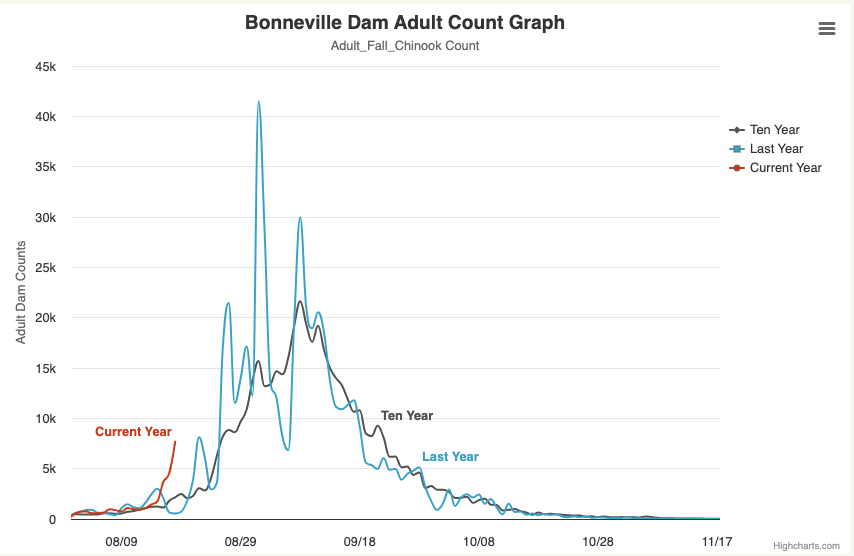
Good Start To Fall Chinook Count At Bonneville
Yes, it’s true. I, Andy Walgamott, swore off watching much less reporting on fish counts ever again less than three weeks ago after the whole Tumwater record sockeye fiasco … but when the fall Chinook tally at Bonneville is off to its best start of the 2000s and probably a lot longer, well, here we are!
Through yesterday, a total of 29,478 of the mighty salmon have swam past the first upstream dam on the Lower Columbia since August 1, when for fish management purposes the fall counting period begins.

That’s nearly twice as many URBS, PUBs and other stocks as the 10-year average, 15,543, and – OK, Walgamott, breathe through your nose now – thousands more fish than even during The Glory Years in the middle of last decade.
(!!!)
Prior to this year, the largest August 1-18 tally since 2000 was 26,995 as 2013 steamed to a bonkers 953,222 fall Chinook; 2015 and its record 954,886 only managed 24,979 in that same two-and-a-half-week timeframe.
Most runs between 1938, when counting at Bonneville began, and 2000 were 300,000 or fewer fish, and checking all of the larger ones, none comes remotely close to this year.
Given that a fast early start notably powered 2024’s Columbia sockeye run to a new record of 755,889 (and still trickling in), the question has to be asked, is this gonna be the year fall kings hit seven digits for the first time?!?
“We noticed the counts are looking good early,” noted WDFW Columbia River manager Ryan Lothrop, who this morning somehow managed to not only feed the buzz but administer several doses of Narcan to this fish count addict.
“… (It) is still early in the run. First two weeks of September are the peak counts, typically,” Lothrop stated. “We also had a major frontal system move through. I heard that people marked a lot of fish but didn’t pick them up on the bite, so that meant they were pushing upriver. Rains and frontal systems can influence passage, much like river flows.”
“If we don’t see a dip in the next few days, that will be helpful,” Lothrop allowed, then added, “Additionally, it might just be a good sign that we don’t have a thermal block.”
Hot water flowing out of the Columbia Basin can slow the passage of fall Chinook and summer steelhead.
Other possible caveats? Lothrop didn’t mention it, but as we learned with the Tumwater sockeye count there in early August, transcription errors do occur between counting stations and counting websites. And as I see that the fall Chinook jack count is also twice the 10-year average, I recall a couple years that saw some very robust immature kings of just over 24 inches, the management cutoff between adult and jack, so maybe something’s going on there.
Stay tuned …
Anyway, along with ongoing sport fisheries on the Lower Columbia (see Buoy 10 and other catch reports and the regs), several nontribal commercial gillnet openers have occurred between the Lewis River and Bonneville – ODFW reports 2,428 fall Chinook landed so far – or will occur on Sunday, Tuesday and Thursday nights through August 30.
